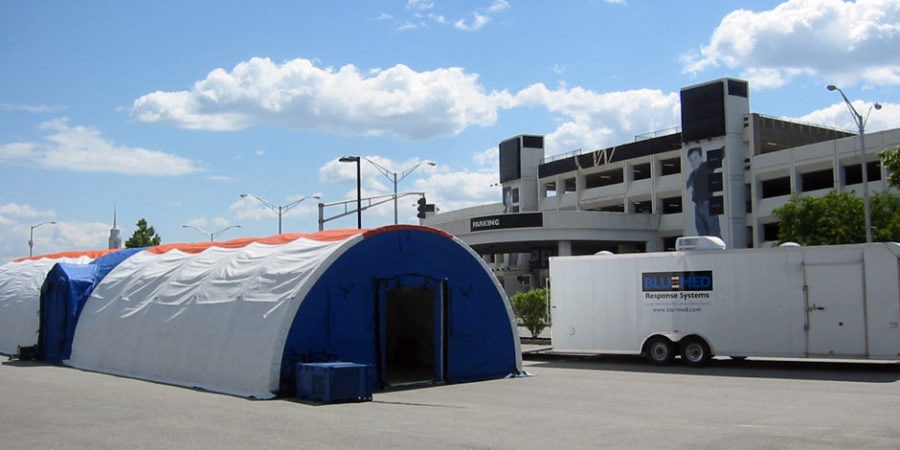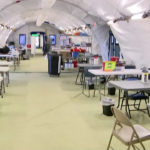The Importance of Mobile Field Hospitals During the COVID-19 Pandemic
It has been over a year since the World Health Organization (WHO) declared an international pandemic due to the COVID-19 virus. Since then, mobile field hospitals have played a crucial role in helping hospital workers care for countless numbers of infected patients.
A little over a year later, with the CDC authorizing three vaccines to help combat the virus, only 41.9% of Americans have opted to get vaccinated (roughly 139 million people).
Despite more than half of U.S. states seeing a significant decline in new coronavirus cases, hospitalizations, and deaths over the past two weeks, there is also an alarming trend of decreasing vaccination rates that has health experts worried. 12 states, including Utah, Oklahoma, Montana, North and South Dakota, and West Virginia, have seen vaccinations decline to 15 daily shots per 10,000 residents. Alabama reported just four people per 10,000 residents getting vaccinated last week.
“Cases are starting to come down. We think that this is related to increased vaccination, increased people taking caution, and so I’m cautiously optimistic that we’re turning the corner,” explained Dr. Rochelle Walensky, the director of the Centers for Disease Control and Prevention. But she warned that “the virus is an opportunist” and could strike in communities with low vaccination rates.
For this reason, mobile field hospitals and deployable medical facilities to isolate and treat patients will remain an important component to the fight against the COVID-19 pandemic.
The Importance Of Mobile Field Hospitals — A Year Into the COVID-19 Pandemic
Here are the ways that mobile field hospitals are aiding hospitals and healthcare workers a year into the COVID-19 pandemic.
Mobile Field Hospitals For COVID-19 Vaccination Sites
Mobile field hospitals have been key to not only treat infected patients with COVID-19, but also to administer vaccinations.
Medical shelters offer the following (and more):
- Temperature-controlled space for storing vaccines or freezer equipment
- Designated prep space for healthcare workers
- Places for patients to wait for their appointment
- The ability to vaccinate many people quickly and efficiently
- Room for patients to sit for the recommended 15-minute observation period
[Related: Medical Shelters for Temporary Vaccination Sites]
Continued COVID-19 Patient Care
Next, mobile field hospitals continue to be important for COVID-19 patient care, even with the availability of vaccines.
Hospitals can continue to benefit from medical shelters to care for their infected patients. These structures help healthcare workers do the following:
- Avoid a lack of bed space. Lack of bedspace is tied to COVID-19-related deaths. With extra room, hospitals can ensure patients in need have beds to improve their chances of survival.
- Improve the quality of patient care. Less overcrowding means more personalized attention for each patient.
- Provide proper isolation. Hospitals can make sure the virus doesn’t spread further by keeping infected patients in their own room.
[Related: Guide to Creating Space for Medical Surge]
Preparing for Future Disasters
A lesson learned during the COVID-19 pandemic: Hospitals must be prepared for the future — COVID or otherwise, and equipped with rapidly deployable medical facilities to increase surge capacity. In the early days of the pandemic, as coronavirus cases skyrocketed and hospitalizations increased, it became apparent that the healthcare industry was not prepared. The scramble to locate alternate care sites, medical shelters, and life-saving equipment need not be repeated.
Whether it’s the rise of a different COVID-19 variant, another infectious disease, or a large-scale disaster, hospitals will be better prepared.
If your hospital hasn’t done so, now would be a good time to order medical shelters or mobile field hospitals from BLU-MED Response Systems®.
[Related: Key Elements of Pandemic-Ready Healthcare Facilities]
Mobile Field Hospitals as Healthcare Worker Respite Spaces
Finally, you can use mobile facilities to keep healthcare workers performing at their best. After all, healthcare workers are the backbone of the healthcare system. Their well-being is crucial for caring for patients.
However, the virus’s impact on medical staff is unbounded. Overflow, patient deaths, and isolation from their families all contribute to emotional and physical fatigue.
For this reason, hospitals can use smaller medical shelters as hospital worker respite spaces to create additional rooms for the following:
- Napping or sleep space when working long or overnight shifts
- Space for meditation to relax and refocus
- A quiet room to call family or friends
- Room to eat meals between shifts
- Gathering space for coworkers to support each other emotionally
[Related: Helpful Ways to Use Hospital Surge Facilities After the Pandemic]
Unmatched Benefits of BLU-MED Mobile Field Hospitals
Equipping hospitals and medical facilities with mobile field hospitals is important. But, not all portable structures are engineered well enough to safely serve patients.
For example, at the start of the pandemic, many hospitals had to rush to create more bed space. As a result, they opted for pop-up tents and canopies that are easily available at local stores or rental party tents.
While these options were a fast solution, they weren’t practical for the long-term needs of creating a safe, temperature-controlled space for healthcare workers to treat and care for infected patients, especially during the cold winter months.
Many hospitals learned quickly that they would need better-quality and “military-grade medical facilities” to create a safe, clean space to administer advanced-level care and opted for medical shelters from BLU-MED Response Systems. Here’s why.
Fast and Simple Setup
BLU-MED’s mobile field hospitals are fast and simple to set up.
They are built to last and tested to withstand 100 setup-strike cycles. BLU-MED medical shelters offer hospitals ease of portability, long-lasting durability, and are easily taken down and stored for future use.
Safety and Comfort in Any Weather
BLU-MED is a division of AKS Industries, Inc. The world’s leading provider of military shelter systems, we have experience with mid-to-long-term operations in harsh and remote locations.
Therefore, BLU-MED medical shelters offer year-round weather protection. They are designed to withstand:
- High winds of up to 100 mph
- Heavy snow loads of up to 20 pounds per square foot
- Up to 4 inches of rain per hour
- Sustained wind speeds of up to 60 MPH
- Wind gusts of up to 75 MPH
In addition, BLU-MED medical shelters can be equipped with portable HVAC systems. The mil-spec HVAC units (environmental control units) are designed to seamlessly connect with any BLU-MED shelter and provide a temperature-controlled medical facility in extreme hot or cold climates.
Electrical and Lighting Systems
Mobile field hospitals from BLU-MED are equipped with electrical and lighting systems.
The electrical and lighting systems are designed to be plug-and-play for easy installation and provide access to power for life-saving medical equipment. Optional power generation and distribution systems can also be ordered to create a self-contained mobile field hospital.
15-Bed Mobile Field Hospital to 200-Bed Hospital Configurations
Another major advantage of BLU-MED medical shelters is that they can create a scalable medical facility. Whether your hospital has a small grass field or a large parking lot, BLU-MED medical shelters can be used to create a 15-bed mobile field hospital or expanded to a 200-bed field hospital (or bigger) with the size and layout to fit your space and medical needs.
Optional Isolation Wards
BLU-MED offers negative pressure isolation shelters, sometimes referred to as “patient isolation tents.” These medical facilities feature partitioned rooms to isolate and treat infected patients, creating a negative or positive pressure space to safely contain infectious diseases. In particular, BLU-MED isolation wards have the following:
- An air distribution system
- A negative pressure scrubber that removes 99.984% of harmful germs in the air
- An alarm system to constantly monitor air pressure
- Nonslip vinyl floors for safety
- And much more
The CDC mandates use of negative pressure isolation in the case of airborne disease. Hospitals should prepare and equip their BLU-MED medical shelters with negative pressure isolation systems.
Contact Us to Discuss Your Mobile Field Hospital Requirements
Contact BLU-MED Response Systems to discuss your mobile field hospital requirement today.


